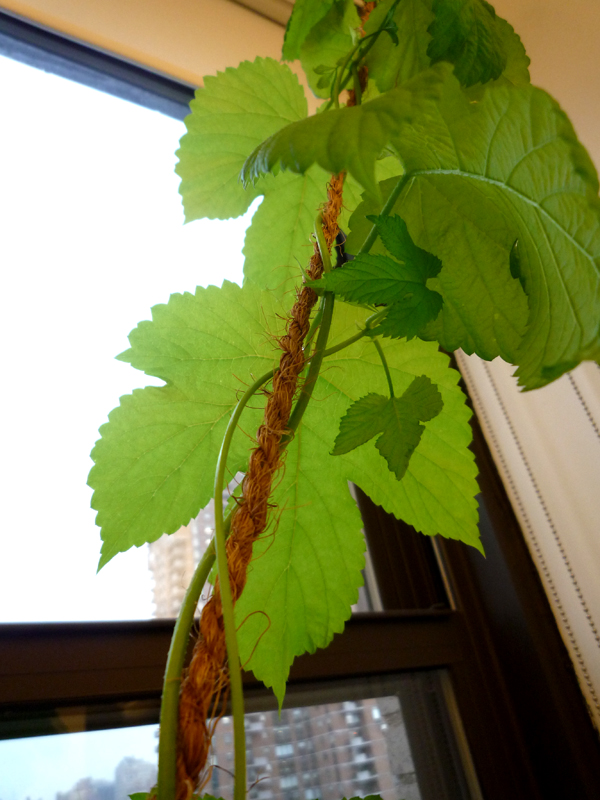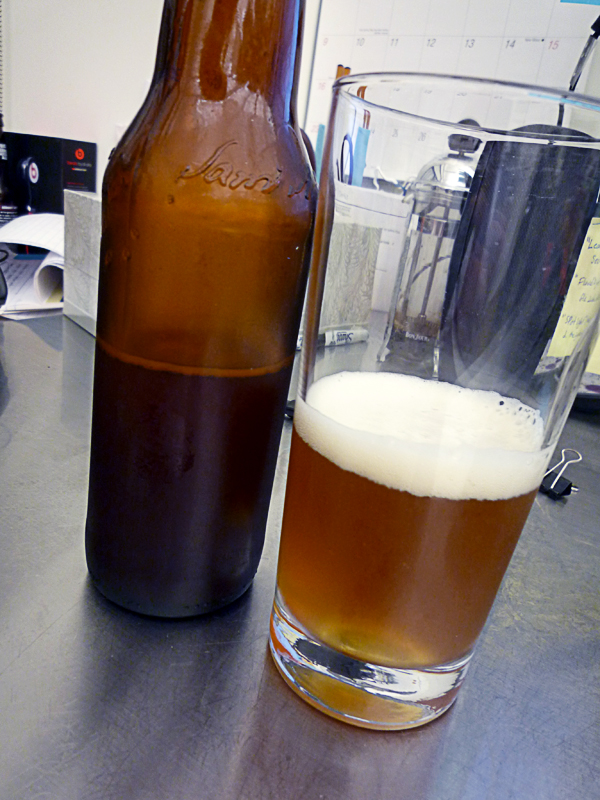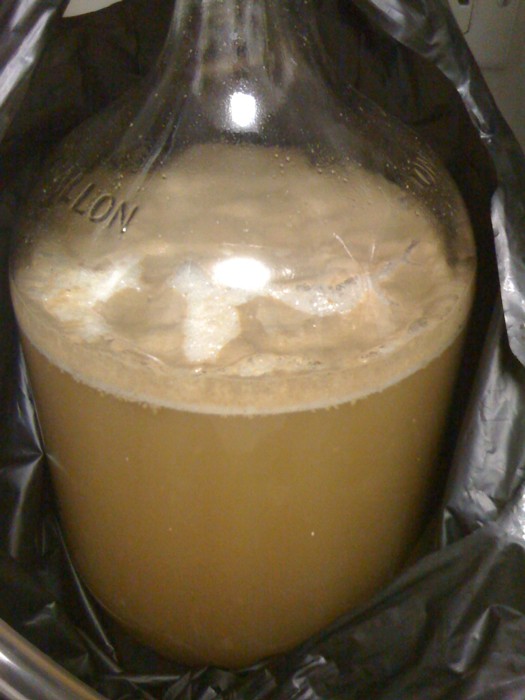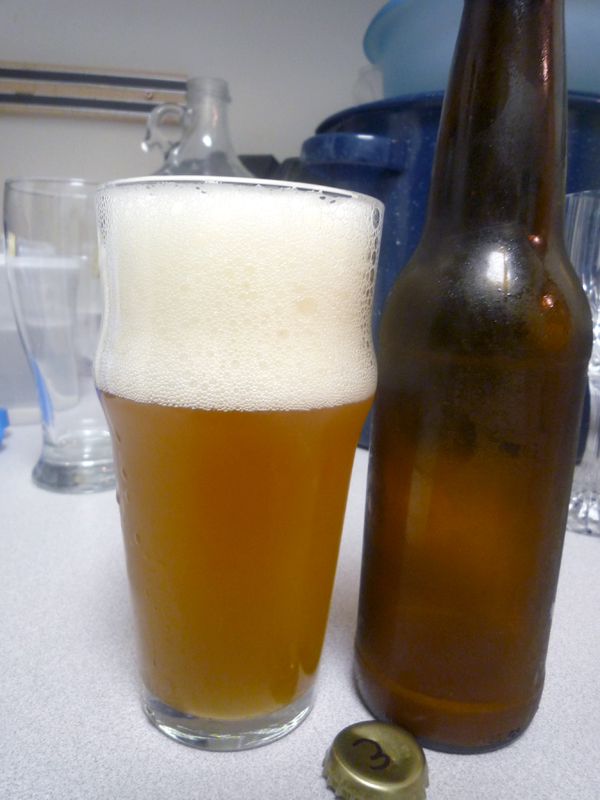Jun
14
2010
I decided it would be fun to grow my own hops. I placed an order from freshgrownhops.com and got 3 rhizomes: a Nugget, a Willamette, and a Sunbeam. I brought the Nugget hop plant to work with me and left the other two at my apartment. Apparently, Firstborn is a great place for a hop plant. In only about one month, the Nugget hop has grown all the way to the ceiling, which must be 7 or 8 feet of rope. It will still be some time until she produces any buds for harvest. (Note: Hop plants actually do have genders, so calling the plant ‘her’ is actually scientifically correct.)


no comments | tags: Homegrown, Hops
Jun
14
2010
I’ve been trying to come up with a name for myself as a brewer, or basically what my brewery would be called. Obviously, I’m not a brewery, or even a brewer in that sense – I just end up messing around and trying to make some delicious beer every now and then. But in the event that I wanted to enter a contents or anything like that, I figure I would need a name for myself. Since I’m a Flash Developer by trade, I wanted the name to have something in common with that. I went though some pretty nerdy names, but finally I settled on Singleton Brewing.
Named after the Singleton pattern in Object Oriented Programming, it was just the right amount of geek yet still sounds “normal” enough to non-developers. Here’s the explanation of the Singleton pattern in a nutshell from Wikipedia:
In software engineering, the singleton pattern is a design pattern used to implement the mathematical concept of a singleton, by restricting the instantiation of a class to one object. This is useful when exactly one object is needed to coordinate actions across the system. The concept is sometimes generalized to systems that operate more efficiently when only one object exists, or that restrict the instantiation to a certain number of objects (say, five). Some consider it an anti-pattern, judging that it is overused, introduces unnecessary limitations in situations where a sole instance of a class is not actually required, and introduces global state into an application.
I have really two thoughts on why I thought Singleton was an appropriate name. (Note: I’m going to talk programming for a bit to explain, so I’ll try not to lose the non-developers here). First, since a Singleton restricts to only one instantiation of an object, it can (loosely) be thought of a “one and only” type of thing – I guess kind of arrogant but still fitting. Secondly, some people think that using a Singleton is hacky and is a bad practice, and at the same time, I might try and do some pretty bizarre experiments (such as the catnip beer, and my current Special Project Series #1 which is currently underway and legally needs be be kept secret under NDA). So, it might not be the strongest connection, but the name seemed to fit without being too nerdy (like “Method Overload Brewery”) and in the end, the name just grew on me.
A current placeholder page is set up at singletonbrewing.com, but don’t expect any real content there for some time.
no comments | tags: Singleton Brewing, Web | posted in Singleton Brewing
Jun
14
2010
Made another attempt at the smoked beer. I used Golden Promise and Crisp Amber Ale for my grains. I only used a half a cup of the Simpson’s Peated Malt. I chose Argentinian Cascade as my bittering hops, and Chinook and Amarillo for bittering and aroma. I also used some Irish moss this time as it is supposed to help with clarity. I went with the Scottish Ale yeast, and the expected ABV is 6.0%.
Again, I felt that the smoke flavor and aroma was too strong. I am going to really reduce it next batch – I’m thinking even less than 1/8 of a cup. I guess the flavors imparted by peated malt are really strong.

no comments | tags: Amarillo, Amber Malt, Argentinian Cascade, Chinook Hops, Golden Promise, Homebrew, Peated Malt, Rauchbier, Smoked | posted in Homebrews, Singleton Brewing
Jun
14
2010
I was super excited to try making this beer. I’m not sure where the idea to add catnip to my beer came from, but I think it might have something to do with me trying to figure a way to piss off my cats. Since I knew that catnip could be used to make tea, I figured beer wasn’t too large of a leap. In fact, I found out afterward that this wasn’t a totally original idea. Apparently, monks had once used catnip when the price of hops were too great. I didn’t use catnip in place of hops, but rather in addition.
So here’s what I used for this batch. For grains, I used Bohemian Pilsner Malt and Golden Promise, which I’ve been using for almost every batch now. I also used a little bit of flaked wheat. I learned that when using wheat in the mash, I needed to add some extra water and pay more attention to it, stirring it more often. For hops, I choose Chinook and Amarillo, and of course added in some fresh catnip. I made sure to add the catnip towards the end of the boil, but I think next time I would add half at where I did (the 0:40 mark) and then steep the rest right after the boil. Finally, I used a Belgian Strong Ale yeast. The expected ABV for this beer is 7.5%.

The result is that I am extremely happy with this beer. In fact, this is my best one yet. There’s really no taste of catnip, and next time I am going to add a lot more, but at the same time I don’t want that to be the focus of the beer. The wheat actually seems to add some nice weight, especially paired with the Strong Ale yeast (if it’s not apparent yet I do like heavier ABV beers).

2 comments | tags: Amarillo, Bohemian Pilsner Malt, Catnip, Chinook Hops, Golden Promise, Homebrew, Wheat | posted in Homebrews, Singleton Brewing




